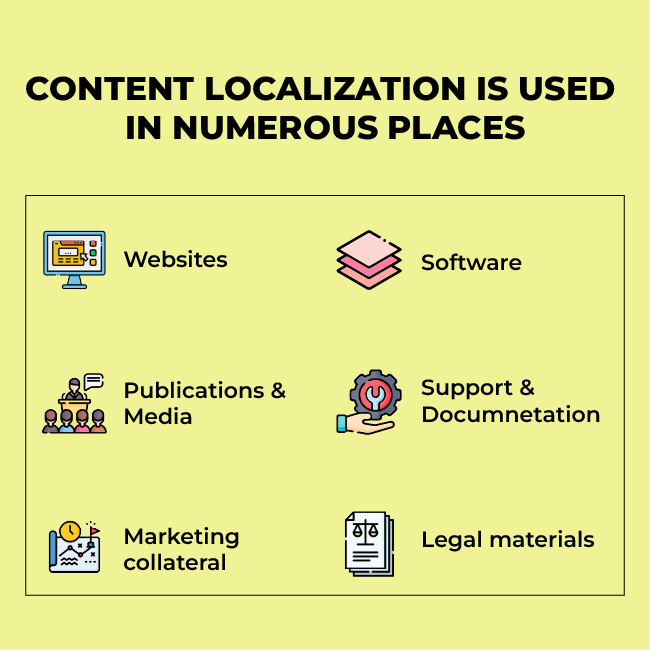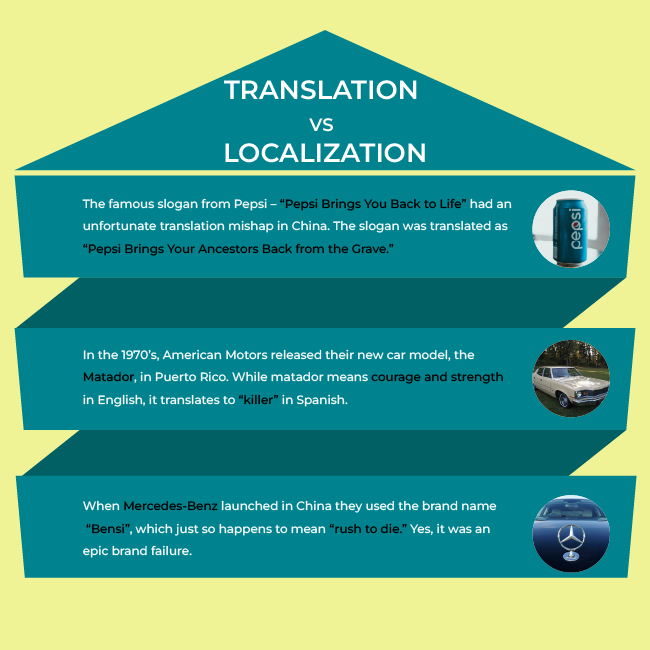5 Ways Content Localization Improves Global Customer Experience
When entering new markets, what sets a brand apart? Localization. To ensure a successful market entry, you must remember to ‘think global but act local’ in order to secure enduring success.
For instance,
“Η τεχνητή νοημοσύνη θα αλλάξει τον κόσμο.”
Does the sentence above hold meaning for you?
If you’re like most English speakers, you probably don’t understand its message. Similarly, if the remainder of this article follows the same pattern, you might just skip it.
This scenario works both ways.
For someone familiar only with the language of the first sentence, the rest of this article would be incomprehensible. This highlights a crucial aspect of the Internet: to communicate with locals effectively, you must speak their language.
According to a recent study, 56% of consumers consider the ability to access product information in their preferred language to be more important than price.
While English remains the most widely spoken language globally, with 1.5 billion speakers, Chinese (1.1 billion), Hindi (609 million), Spanish (559 million), and numerous other languages represent a significantly larger portion of the world’s population. Therefore, businesses aiming to establish themselves in new markets must adapt their content to resonate with diverse audiences through localization.
But how can you achieve this localization?
This blog will provide you with insights into creating content that transcends geographical boundaries and connects with various cultures. From language adjustments to cultural sensitivity, discover how to effectively engage global audiences while staying true to authenticity and relevance.
Table Of Content
➤ What is Content Localization?
➤ Translation VS Localization
➤ Why is Content Localization important?
➤ Ways Content Localization Improves Global Customer Experience
➤ Knowing When to Implement a Content Localization Strategy
➤ Challenges You May Encounter When Localizing Content
➤ Steps to include in your customer experience roadmap
➤ Tips to build a Successful Content Localization Strategy
➤ Localize All Your Customer Communications with Perfect Doc Studio
What is Content Localization?
Localization is crucial for effective communication across diverse languages and cultures. When you localize your content, you’re not just changing the language; you’re embracing the nuances that define each culture. It’s about adapting your language, style, design, and even units of measurement to resonate with your audience’s culture.
When brands localize their content, they aim to make you feel understood and catered to, just like being at home. For example:
- You might find articles on websites translated into three different languages.
- Marketing materials are adjusted to match cultural norms and avoid offending you.
- Measurements, currencies, and date formats are converted to match your local standards.
- Product offerings may be tailored to coincide with local holidays.
- Legal and regulatory information specific to your region is incorporated into content.
- Customer support services are provided in your native language.
- Pricing strategies are customized to suit the economic conditions of your market.
Many companies think of localization as simply translation. But it’s more than that. It’s a complete personalization of content, taking into account the tone, cultural sensitivities, and your preferences. It’s about making sure you can easily engage with and understand the content in a way that feels natural to you.

Translation VS Localization
Translation is when you change a piece of content from one language (the source language) to another language (the target language). For instance, if you have an English resource guide and you expand your company to Paris, you might translate it into French. Later, if you target the Spain market, you might translate it again into Spanish.
This method can alter the message of the content and may lead to errors and cultural misunderstandings.
Just translating the content doesn’t account for cultural disparities. Content translated to Spanish for Spain might not have the specific syntax needed for Mexican Spanish.
Content localization, however, involves creating content that stands alone, technically correct and adapted to the cultural differences, search marketing practices, and legal requirements of the two markets.

Considering Localization vs. Translation? Learn more about which approach suits your global strategy by clicking to read the blog.
Why is Content Localization important?
Picture this scenario: Your company is organizing two tech expos—one in San Francisco and the other in Seattle. Your task is to develop promotional materials, including a landing page, brochures, a Facebook event, and a visitor’s guide for each city. Although the language remains constant, you recognize the need for diversity in images and content, don’t you?
The speakers may focus on different tech trends, tailored to the preferences of each city’s tech community. For instance, in San Francisco, certain colors like blue might resonate well, while in Seattle, they could evoke associations with the Seahawks football team.
You’d opt for San Francisco-centric images for the expo there and Seattle-themed visuals for the event in the Emerald City. Additionally, your recommendations for local eateries and directions to the expo venue would vary, as would the online marketing tactics used to sell tickets.
This example underscores the significance of content localization, showcasing how it can greatly influence content creation, even within the same country.
Here are some key benefits of localization software testing that can enhance your user experience:
- Ensure Compliance: Localization testing ensures that your software meets regulatory requirements and satisfies the needs of your target audience, leading to higher customer satisfaction.
- Reduce Costs: By catching localization bugs early on, you can avoid costly rework and fixes during production, saving you money in the long run.
- Retain Customers: Tailoring your software to regional preferences enhances the overall customer experience, reducing churn rates and boosting brand loyalty.
- Expand Your Reach: A well-localized app attracts more users and opens doors to new markets, helping your business grow and thrive.
Ways Content Localization Improves Global Customer Experience
Localization gives your messages a more personal touch:
Every corporate message is meticulously crafted by a writer to convey a specific idea. That writer employs phrasing and cultural references not only to make a point but also to establish and maintain a brand voice.
A distinct brand voice aids potential clients in understanding your corporate identity. It’s what ensures your brand maintains a consistent personality across various content types and platforms.
Simply translating words and sentences without further adaptation fails to preserve your brand voice across different languages. However, localization ensures your message resonates with local customers in diverse global markets. By localizing content, you can forge a deeper connection with every customer, even those who aren’t fluent in your brand’s native language.
Moreover, we understand that today’s buyers worldwide seek personalized experiences from the brands they endorse. Increase engagement by tailoring your message to each customer in every market through localization.
Localized marketing delivers what you want:
Different cultures have different preferences, and your company’s marketing materials must reflect these differences. For instance, a retailer targeting young women in the US might emphasize the latest trends and affordable prices to encourage consumers to stay fashionable. However, upon entering the French market, the focus may shift towards timeless aesthetics and quality pieces that complement each customer’s individual style.
Discover how to enhance customer experiences through Behavioral Design techniques, here!
Understanding differences in belief systems is also crucial for global marketers:
In Japan, Kit Kat is not just a chocolate bar; it’s a cultural phenomenon. Nestlé realized that traditional Kit Kat flavors might not resonate with Japanese consumers as much as unique and seasonal flavors would. So, they introduced a wide range of flavors like green tea (matcha), cherry blossom (sakura), sweet potato (satsumaimo), and wasabi. These localized flavors tapped into Japanese preferences and traditions, making Kit Kat one of the top-selling chocolate brands in the country.
These strategic steps, though complex and labor-intensive, paid off, as they aligned the chain’s offerings and advertising with local culture, driving engagement and ensuring success.
Customers respond better to ads tailored to them:
According to a study by Common Sense Advisory, over 72 percent of consumers prefer shopping on websites in their native language, with 55 percent exclusively purchasing from such sites. This preference is understandable—who would buy a product if they couldn’t fully comprehend its description? Localization addresses this issue.
Localization is just as vital between dialects as it is between languages. When a product or service is launched in multiple countries, the language used in the content must be localized. For example, American English spellings like “color” need to be changed to British English spellings like “colour” for the UK market.
When you localize your content, you’re conveying to your customers that you value communication with them. Content feels much more familiar and comforting when presented in the audience’s native dialect, demonstrating a level of sensitivity and respect that fosters engagement.
Localization services help you avoid cultural missteps:
In certain Asian cultures, the act of pointing directly at someone or something with the index finger is considered rude or aggressive. Conversely, in Western cultures, pointing is often used casually to indicate direction or draw attention. Therefore, a marketing campaign featuring individuals pointing directly at the viewer may be well-received in the West but could be seen as disrespectful or confrontational in certain Asian markets.
Mistranslated text can also cause problems. Stories abound of companies translating slogans literally, with unfortunate outcomes.
Such mistakes, however seemingly harmless, can deeply offend local communities and tarnish a company’s reputation. Skilled localization can help marketers convey the intended message while averting negative publicity and resentment from local markets.
Localization makes content relevant and engaging:
When the Nieman Journalism Lab tested targeted social media posts, they found that locally-targeted content performed six times better than globally-shared posts. According to Lathan Fritz, founder of Amerisales, geo-targeting is effective because it establishes a deeper connection with prospective customers compared to generic advertisements. When you localize your customer messages instead of just translating them, it helps your audiences feel more personally connected and engaged.
Knowing When to Implement a Content Localization Strategy
When it comes to expanding your brand’s global reach and resonating with diverse audiences, a well thought out content localization strategy is essential. However, determining the right time to embark on this journey can be challenging. Here’s a guide to help you recognize the signs indicating when it’s time to consider implementing a content localization strategy.
1. Expanding into New Markets:
If you’re planning to enter new international markets, it’s crucial to adapt your content to resonate with local audiences. Signs it’s time to localize your content include:
|
Market Research Insights |
Your market research indicates significant potential in specific regions or countries. |
|
Cultural Sensitivity |
You’ve identified cultural nuances that require tailored messaging to connect authentically with local audiences. |
|
Competitive Landscape |
Competitors are already successfully engaging with local audiences through localized content. |
2. Diverse Audience Segments:
When your target audience encompasses diverse cultural backgrounds and languages, localization becomes essential. Signs to look for include:
|
Audience Feedback |
You’re receiving feedback from diverse segments indicating a disconnect or lack of resonance with your current content. |
|
Demographic Shifts |
Changes in your audience demographics, such as an increase in non-native language speakers, signal the need for localized content. |
|
Inclusive Branding |
Your brand values inclusivity and seeks to make all audience segments feel seen and heard. |
3. Improving Engagement and Conversion Rates:
Localization can significantly impact engagement and conversion rates, especially when:
|
High Bounce Rates |
Visitors from specific regions or language preferences have high bounce rates, indicating a lack of engagement with your content. |
|
Low Conversion Rates |
Your conversion rates are lower than expected in certain markets or among specific language-speaking audiences. |
|
Language Barrier |
Language serves as a barrier preventing users from fully understanding and engaging with your content. |
4. Enhancing Brand Reputation and Trust:
Localizing content can help build trust and credibility with your audience, particularly when:
|
Perception Challenges |
Your brand faces perception challenges or misconceptions in specific regions that can be addressed through localized messaging. |
|
Cultural Sensitivity |
Cultural insensitivity in your current content has led to negative feedback or backlash from local audiences. |
|
Brand Consistency |
Maintaining consistency in brand messaging while adapting it to local contexts reinforces your brand’s authenticity and trustworthiness. |
Recognizing the signs indicating when to consider a content localization strategy is essential for staying competitive in today’s global marketplace. By proactively adapting your content to resonate with diverse audiences, you can expand your brand’s reach, improve engagement and conversion rates, and enhance your brand’s reputation and trustworthiness on a global scale.
Challenges You May Encounter When Localizing Content
As you embark on localizing your content, you’ll find it can open up new markets and increase engagement. However, this process comes with its own set of challenges.
Maintaining Quality and Consistency
Ensuring that your localized content accurately conveys your message while preserving its nuances can be tricky. It’s also important to maintain your brand’s unique tone and voice, and to have the resources to identify quickly and correct any errors in the localization process.
Understanding Regional Nuances
It’s crucial to be aware of the differences between regions and countries. For example, in Latin America, a single word can have different meanings (and sometimes be offensive) across countries that speak Spanish. Simply translating content wouldn’t be sufficient for effective localization in this region.
Facilitating Collaboration
Coordinating between local teams and regional partners can be challenging, especially when dealing with timezone differences. Having proper workflows and iteration loops in place for feedback and approvals is essential for successful collaboration.
Don’t be discouraged by these challenges! We’ve compiled a set of steps to incorporate into your customer experience roadmap.
Steps to include in your customer experience roadmap
Here are steps for you to include in your customer experience roadmap to ensure localization is considered at each stage:
Research Your Target Market
Start by researching your target market, including their language, culture, and regulatory requirements. This will help you understand their localization needs and identify any potential regulatory issues upfront.
Localize Your Content
Once your research is complete, decide which content to translate, such as website copy and marketing messages. Ensure that the content you select addresses your audience’s specific needs and is customized for their language and cultural preferences.
Adapt the User Experience
Customize the layout and navigation of your product to suit the end users in your target market. This will ensure that your website and digital touchpoints are user-friendly for customers in different regions.
Test with Your Target Audience
Before launching a fully localized product or service, conduct testing with a segment of your target audience. This will help you identify any issues with language, cultural references, or regulatory compliance that need to be addressed before release.
Implement an Evaluation Plan
Your CX roadmap should include an evaluation plan focused on continuous improvement. This plan should involve ongoing research, testing, and adaptation to ensure that your localized content and user experience remain relevant and appropriate for your target market’s language and culture over time.
Tips to build a Successful Content Localization Strategy
Do you want to expand your reach and connect with diverse audiences around the globe? Crafting a successful content localization strategy is the key to unlocking new markets and fostering meaningful engagement with your target demographics.
Here are some invaluable tips to guide you on your journey to becoming a localization champion:
- Understand your target audience’s cultural nuances to tailor content effectively.
- Invest in professional translation services to maintain linguistic accuracy.
- Adapt visuals and imagery to resonate with diverse cultural preferences.
- Prioritize consistency across all localized content to maintain brand integrity.
- Utilize local influencers and partnerships to enhance credibility and reach.
- Leverage data analytics to refine localization efforts and optimize performance.
- Embrace feedback loops from local markets to refine your strategy continuously.
- Cultivate a deep understanding of local SEO practices to improve visibility.
- Incorporate localization early in content creation to streamline the process.
- Stay agile and adaptable to evolving cultural and market trends.
Localize All Your Customer Communications with Perfect Doc Studio
In today’s globalized world, effective communication with customers in their native language is crucial for businesses looking to expand their reach and build lasting relationships. Perfect Doc Studio offers a comprehensive solution for localizing all your customer communications, ensuring that your message resonates with audiences worldwide.
➤ Auto-Translations in 100+ Languages
With Perfect Doc Studio, you can effortlessly translate your communications into over 100 languages, allowing you to reach a diverse audience without the need for manual translation. Our advanced translation technology ensures accuracy and consistency across all languages, so you can communicate with confidence.
➤ Automate Content Writing in 100+ Languages
In addition to translations, Perfect Doc Studio also offers automated content writing in over 100 languages. Our AI-powered content generation tools can help you create engaging and relevant content for your customers, saving you time and resources while maintaining a consistent brand voice.
➤ Retain Customers with Geo-Personalized Digital Experience
Perfect Doc Studio goes beyond translations and content generation to offer a geo-personalized digital experience for your customers. By tailoring your communications based on the location and preferences of your customers, you can create a more personalized and engaging experience that keeps them coming back.
➤ It Takes Months to Find a Customer, Only Seconds to Lose One
At Perfect Doc Studio, we understand the value of every customer relationship. That’s why we’re dedicated to helping you retain customers with our comprehensive localization and personalization tools. With our platform, you can ensure that every interaction with your customers is meaningful, impactful, and memorable.
Localizing your customer communications is essential for building trust, loyalty, and lasting relationships with your customers. With Perfect Doc Studio, you can easily translate, automate, and personalize your communications to create a truly global brand that resonates with audiences worldwide. Start localizing all your customer communications today with Perfect Doc Studio and see the difference it can make for your business.
Conclusion
The most important step you can take is to test your localization strategy to determine what you’re doing (and what you need to do) in each foreign market. You’ve done the research and you understand your new target audience. Now it’s time to get out there and put it into practice. Remember that building trust with new audiences takes time. Don’t expect your localization strategy and revamped marketing efforts to be an overnight success.
Here are a few key takeaways to keep in mind:
- Focus on understanding your new market with consumer-focused research. Teaming up with a local partner is key.
- Prioritize website content localization in the respective local languages with additional human translations.
- Stand out from your competition by offering value-added services.
- Produce authentic local content that’s targeted to your global audience, and use the correct social media channels and offline spaces.
FAQ
1. How does content localization impact SEO and organic search visibility?
By localizing content, you can include relevant keywords, phrases, and cultural references that are more likely to be used by local audiences when searching online. This can improve your organic search rankings and visibility in local markets.
2. What are the key benefits of content localization for global businesses?
Content localization can lead to increased customer trust, loyalty, and satisfaction by demonstrating an understanding of local needs and preferences. It can also help businesses expand their global reach and drive more conversions.
3. How can businesses ensure effective content localization for their global audience?
Businesses can start by conducting thorough market research to understand their target audience’s preferences and cultural nuances. They should also work with professional translators and localizers to ensure accurate and culturally appropriate content.
4. Can content localization help businesses improve their international marketing strategies?
Yes, content localization is a crucial aspect of international marketing. It allows businesses to tailor their messaging to specific markets, leading to more effective communication and engagement with global audiences.
5. How can businesses measure the effectiveness of their content localization efforts?
Businesses can track key performance indicators (KPIs) such as website traffic, engagement metrics, and conversion rates in different markets to gauge the impact of their content localization efforts.
Why Organizations Struggle with Customer Communications: Insights & Solutions
Effective communication is vital for any organization, especially when it comes to communicating wit
‘Design for emotion’ in customer communications
When designing with emotion, you are communicating with your target audience. It is possible to make




